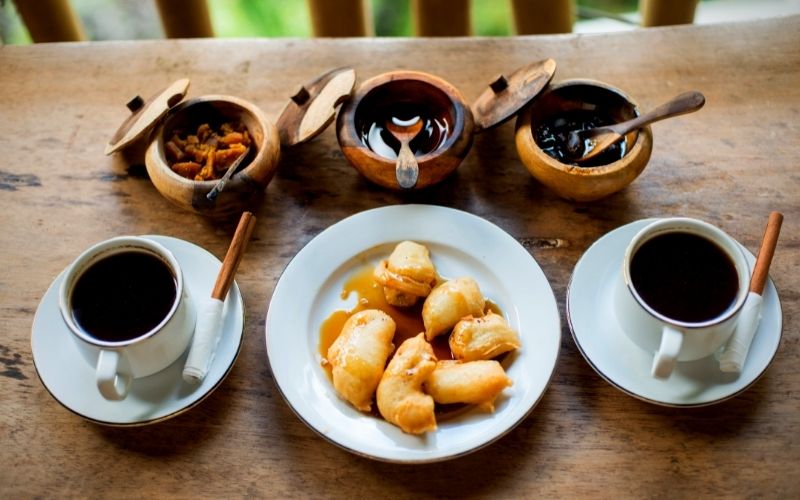
Love it or hate it (though, chances are you love it), coffee has become a staple in people’s homes and lives around the globe.
So, what is the history of coffee and where did coffee originate?
The general belief is that coffee did begin its journey in Ethiopia. But early on, Ethiopians started exporting the coffee plant to Yemeni traders. The traders then began planting and growing the crop in Yemen, accounting for its history there, as well.
Before we get there, let’s clarify the basics of everyone’s favorite pick-me-up.
What is Coffee?

You may have wondered, where does caffeine come from? Caffeine is a stimulant that affects the central nervous system, and it’s found in plants like coffee beans. So, then, where do coffee beans come from?
The coffee beans that we know and brew are actually the seeds of the coffee cherry, a small red fruit that grows in various locations worldwide. Coffee experts say that there are approximately 25 to 100 species of the coffee plant, accounting for the wide variety of coffee we have today.
Where Does Coffee Come from?

Home to the Arabica coffee, Ethiopia is widely considered to be the original source of coffee in the world. Ethiopia may have been the place of coffee’s origin, but when was coffee invented? And who invented coffee?
The Facts
Coffee is Ethiopia’s primary export, and part of its popularity is due to Ethiopia’s centuries-old coffee background.
Coffee history in Ethiopia dates back to the 9th century, as far as linguists can tell. Extant Arabic documents have been found that include the Oromiyan word “buna” – the name of a drink that had swept the nation at that time.
Oromiyan is an Ethiopian language, and today it is the most widely spoken language in Ethiopia. In modern Oromiyan, “buna” is the word for “coffee.” From this, we can determine that the current term for “coffee” appearing in such an ancient source is likely not a coincidence. And this offers strong evidence that Ethiopia is, in fact, the original home of coffee.
The Fiction
Many Ethiopians don’t need to rely on linguistic evidence to tell you that coffee originated in Ethiopia. There is a well-known myth surrounding the drink’s origin that has been passed down for centuries.
The myth details that in the 9th century, a goat-herder named Kaldi was tending to his goats when he noticed their sudden behavior change. The goats appeared louder and more energetic, and Kaldi noticed that they had been grazing on a shrub containing small red berries. Curious, Kaldi tried some of these berries for himself and soon felt the stimulating high that they roused.
The story continues that Kaldi shared his discovery with his wife, who excitedly insisted he take his berries to the local monastery.
Unfortunately, the introduction was not smooth. The monks rebuffed Kaldi and his berries, claiming they were the work of the devil. Then, the monks discarded the berries into the fire. The fire-roasted coffee beans inside the fruits created a pleasant scent that soon attracted the monks around the monastery.
The aroma was enough for the monks to try the fruit themselves. However, since they could not eat the berries’ now-roasted beans, they ground them up and mixed them in hot water, resulting in the prototype beverage that we continue to drink centuries later.
Coffee’s Journey Around the World
Coffee’s journey across the world wasn’t always smooth sailing. Find out below how the world’s second most traded commodity started its adventures.
The Middle East

As we mentioned earlier, the coffee trade began with Yemeni traders importing the beans to Yemen, specifically through the port city of Mocha. If that name rings any bells, that’s because the port became synonymous with its chief import, and is the origin of the coffee variety called Mocha today.
Yemen might not have been the place of origin of coffee, as some myths relate, but it was certainly one of the first places where coffee was produced.
Yemenites started planting and producing coffee on their home soil, and soon after became the hotspot for coffee across the Arabian Peninsula. Virtually any other Arabian country who wanted coffee beans imported them from Yemen. By the 16th century, coffee was a staple in Turkey, Egypt, Syria, and Persia.
Across the Arabian Peninsula, people could enjoy coffee in their local qahveh kaneh, public coffee houses. These coffee houses were a place for people to hang out, relax, and socialize. Not much has changed!
Asia

By the beginning of the early 18th century, coffee beans and seedlings eventually made their way further east to Asia. In places like Indonesia and Southern India, coffee farming became popular on a large scale for both local consumption as well as for exporting.
Southern India to this day remains a stronghold for coffee farming and exports world-wide.
In fact, the primary Indonesian island for coffee production was Java – another etymology to add to your list of coffee facts!
Europe

A few failed farming attempts proved that Europe’s colder climate was not ideal for coffee production. But this didn’t stop the beverage from sweeping the continent.
Coffee was already a popular beverage from the 16th century, and by the mid-17th century, hundreds of coffee houses had been established across the continent.
Famously, England established ‘penny universities’ – social houses where visitors could pay a penny to enter. Inside, they had access to coffee, newspapers, and the opportunity to engage with others on a variety of stimulating topics.
Over the Atlantic

Coffee was introduced to the Americas in the early 18th century. The Mayor of Amsterdam gave King Louis XIV of France a small coffee plant as a gift and the plant was kept under close protection in the Royal Botanical Gardens in Paris.
A visiting French Navy captain, Gabriel Mathieu de Clieu, acquired a coffee seedling from the plant and took it with him on his journey back to Martinique. Whether the seedling was acquired ethically or not is up for debate, but the ends appeared to have justified the means.
The seedling was planted in Martinique and thrived in the Caribbean climate. Coffee planting spread across other Caribbean islands, all from this one seedling. More remarkable still, this (potentially stolen) coffee seedling is responsible for all coffee plants grown throughout the Caribbean and Central and South America.
Brazil’s introduction to coffee was also tumultuous. Attempts at bringing coffee beans into the country had failed repeatedly, but they had a stroke of luck when Brazil was asked to intervene in a land dispute between French Guiana and Suriname.
A Brazilian officer, Francisco de Melo Palheta, was sent on the assignment and was additionally tasked with retrieving some coffee beans. The trip was a success on both fronts, and today Brazil is the largest coffee producer in the world.
The Future of Coffee?

Coffee has been around the world and in millions — if not billions — of cups in cafes and homes. And possibly its best trait, beyond the fact that gives caffeine-lovers their fix, is that coffee is so personal and customizable. Coffee lovers have since invented a variety of drinks to suit their tastes, such as lattes, cappuccinos, iced coffee, whipped coffee, etc. Although the future is unknown, it´s probably not an exaggeration to predict that coffee will be a staple in households worldwide for as long as the world exists. The history of coffee is intriguing, but its future is even more so. With more flavors, blends, and brewing styles than ever before, every coffee drinker can have their perfect cup, in any place and time.
